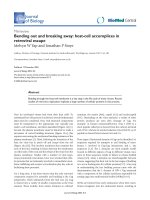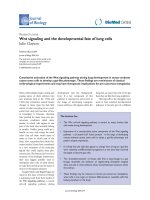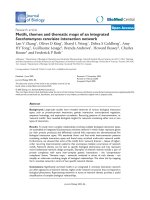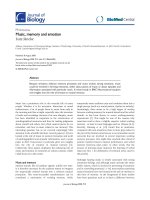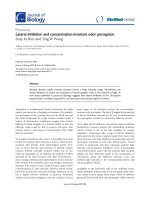Báo cáo sinh học: " Restricted selection and effective population size" pdf
Bạn đang xem bản rút gọn của tài liệu. Xem và tải ngay bản đầy đủ của tài liệu tại đây (560.84 KB, 11 trang )
Original
article
Restricted
selection
and
effective
population
size
RP
Wei*
Department
of Forest
Genetics
and
Plant
Physiology,
Swedish
University
of
Agricultural
Sciences,
901
83
Urrcea,
Sweden
(Received
22
May
1995;
accepted
6
March
1996)
Summary -
A
simple
and
flexible
selection
method,
’restricted
truncation
selection’,
has
been
developed
to
screen
superior
individuals
from
populations
with
family
structure.
’Restricted’
means
placing
limits
on
the
contributions
of
families
to
the
selected
group
and
on
the
number
of
families
allowed
to
contribute.
Selection
is
made
on
the
basis
of
individual
performance
judged
by
phenotype
or
breeding
value
estimate.
Formulae
have
been
derived
to
predict
the
approximate
effective
population
size in
the
selected
group.
Changes
in
the
restrictions
used
modify
the
distribution
of
family
contributions
and
thus
lead
to
different
effective
sizes
in
the
selected
population.
Effective
size
is
influenced
by
sib
type,
heritability,
selection
intensity,
initial
family
number
and
size.
It
is
decreased
by
restrictions
on
the
family
number
but
increased
by
restrictions
on
family
contributions.
The
application
of
the
predictions
of
effective
sizes
to
planning
a
breeding
population
is
discussed.
selection
/
family
/
truncation
/
effective
size
Résumé -
Sélection
avec
restriction
et
effectif
génétique.
Une
méthode
de
sélection
simple
et
flexible,
appelée
«sélection
par
troncature
avec
restriction»,
a
été
mise
au
point
pour
retenir
les
individus
supérieurs
dans
des
populations
à
structure
familiale.
La
restriction
revient
à
imposer
des
contraintes
sur
la
contribution
des
familles
au
groupe
sélectionné
et
sur
le
nombre
de
familles
autorisées
à
contribuer.
La
sélection
est
basée
sur
la
performance
individuelle
phénotypique
ou
sur
une
estimée
de
valeur
génétique.
Des
formules
approximatives
de
calcul
de
l’effectif
génétique
du
groupe
sélectionné
sont
données.
Des
changements
dans
les
contraintes
appliquées
modifient
la
distribution
des
contributions
familiales
et
conduisent
ainsi
à
des
effectifs
génétiques
différents
dans
les
populations
sélectionnées.
L’effectif
génétique
dépend
du
type
de
famille,
de
l’héritabilité,
du
nombre
initial
de
familles
et
de
leur
taille.
Cet
effectif
diminue
si
on
impose
des
contraintes
sur
le
nombre
de
familles
mais
augmente
si
les
contraintes
portent
sur
les
contributions
familiales.
L’application
des
prédictions
d’effectif
génétique
dans
la
planification
d’expériences
de
sélection
est
discutée.
sélection
/
famille
/
troncature
/
effectif
génétique
*
Correspondence
and
reprints:
Department
of
Renewable
Resources,
University
of
Al-
berta,
Edmonton,
AB
T6G
2Hl,
Canada
INTRODUCTION
In
a
population
with
uniform
family
structure,
selection
leads
to
different
families
making
different
contributions
to
the
selected
group.
Effective
population
size,
if
concerning
family
number
(Robertson,
1961),
is
thus
always
lower
in
the
selected
population
than
the
initial
size,
except
when
all
families
contribute
the
same
numbers
of individuals.
Reduction
of
effective
population
size
is
an
inevitable
effect,
for
example,
of
truncation
selection
based
on
either
phenotype
or
optimal
index
(Lush,
1947;
Robertson,
1961;
Burrows,
1984;
Falconer,
1989).
Wei
(1995)
has
therefore
proposed
a
modified
truncation
selection
method
in
which
restrictions
are
placed
on
the
number
of
individuals
selected
from
a
family,
and
also
on
the
number
of
families
from
which
selections
are
made.
It
has
been
shown
that
truncation
selection
with
restrictions
can
be
used
for
the
manipulation
of
both
effective
size
and
genetic
gain
in
the
selected
population
(Wei,
1995).
This
study
attempts
to
increase
the
general
applicability
of
the
method
and
to
derive
approximate
formulations
for
predicting
the
effective
size
following
selection.
ASSUMPTIONS
AND
SELECTION
THEORY
Consider
a
group
of
m
unrelated
or
equally
related
families,
each
of
s
members
that
are
genetically
related
by
the
coefficient
of
relatedness,
r.
The
observed
phenotypes
of
all
individuals
are
recorded.
The
phenotype
of
the
kth
individual
of
the
jth
family
could
be
expressed
as
the
sum
of
two
independent
variables.
where
Xj
are
family
means,
and
d!k
are
within-family
deviations.
If
the
family
means
have
variance
o,
and
within-family
deviations
have
variance
Q
w,
the
total
phenotypic
variance,
!t ,
is
af
=
Qb
-f-
<7!
and
the
ratio
of
the
phenotypic
variance
of
family
mean
to
the
total
phenotypic
variance
is
Selection
criteria
will
be
the
phenotypic
value
or
optimal index
that
best
predicts
the
breeding
value
of
an
individual
(Lush,
1947;
Falconer,
1989).
In
the
following
development
the
index
will
be
treated
in
the
same
way
as
phenotypic
value
but
with
a
different
value
for
the
ratio
(K
*)
of
the
variance
of
family
mean
to
the
total
variance
given
by
Wei
and
Lindgren
(1994)
in
the
form
A
proportion
(P)
of
individuals
will
be
selected.
Two
restrictions
are
imposed:
one
on
the
maximum
number
(s
r)
of
individuals
that
may
be
contributed
by
a
family
and
one
on
the
number
(m
r)
of
families
that
are
allowed
to
contribute.
Thus,
the
mr
top-ranking
families
with
the
Sr
top-ranking
individual
in
each
family
are
shortlisted.
Superior
individuals
are
finally
truncated
from
the
shortlist,
on
the
basis
of
phenotypic
value
or
optimal
index.
Let
P1
=
s
r/
s
and
P2
=
m
r/m,
the
proportions
of
the
restrictions
sT
and
mr
to
the
family
size
and
number
respectively.
The
extreme
cases
of
restricted
selection
with
specified
P1
and
P2
values describe
conventional
selections
and
one-
step
restricted
selections
as
follows
(Falconer,
1989;
Wei,
1995;
Wei
and
Lindgren,
1996).
When
both
P1
and
P2
are
one,
selection
is
based
on
either
phenotypic
or
optimal
index
value
but
is
unrestricted.
P1
=
P
(and
thus
P2
=
1)
describes
within-family
selection,
and
P2
=
P
(and
thus
P1
=
1)
corresponds
to
between-
family
selection.
Selection
with
P1P2
=
P
represents
the
permutations
of
combined
between-family
and
within-family
truncation.
One-step
restricted
selection
means
restrictions
being
imposed
on
either
just
family
number
(P
2
=
1)
or
just
family
contributions
(P
i
=
1).
EFFECTIVE
POPULATION
SIZE
AND
APPROXIMATIONS
Let
n!
denote
the
number
selected
from
the
jth
family
and
total
selections
n
=
En
j.
Two
types
of
definitions
for
effective
population
size
are
considered:
and
where
E(n! )
is
the
second
moment
of
nj
samples
and
E[n! (n! -
1)]
is
the
second
factorial
moment.
Both
were
developed
for
considering
inbreeding
effect
in
offspring
(N
R
by
Robertson,
1961;
NB
by
Burrows,
1984)
although
the
values
may
have
potential
uses
in
other
senses.
Considering
selfing
of
selected
individuals
into
random
mating,
0.5[r/N
R
+
(1 -
r)/n]
is
the
average
inbreeding
coefficient
(OF)
of
progeny.
If
selfing
is
excluded,
0.5/N
B
is
then
the
average
pairwise
coancestry
in
the
selected
group
relative
to
the
parents
of
the
population,
and
therefore
is
the
average
inbreeding
coefficient
of
progeny
produced
by
random
mating
among
selected
individuals.
For
planning
breeding
programmes,
breeders
often
need
to
predict
selection
differentials
(genetic
gain)
as
well
as
effective
population
size
by
using
existing
information
(eg,
K
value)
and
designated
operation
parameters
(m,
s,
P,
Pi,
P2
in
the
present
case).
Here
we
proceed
in
analogy
with
Burrows
(1984)
and
Wei
and
Lindgren
(1996)
to
reformulate
[1]
and
[2]
to
enable
the
prediction
of
effective
size.
We
assume
that
U!
represents
the
number
of
individuals
in
the
jth
sampled
family
with
performance
exceeding
the
truncation
point
relative
to
P,
P1
and
P2.
Thus,
they
sum
to
a
random
variable
and
are
distributed
over
integers
0,1, ,
sr.
As
shown
in
the
Appendix,
the
required
moments
of
U!
are
and
where
Nr
(K,
P,
P1,
PZ)
stands
for
the
corresponding
effective
population
size
under
selection
from
a
population
of
infinitely
large
family
number
and
size.
Let
f (x)
denote
the
density
function
of
the
family
mean
(x)
in
an
infinite
population,
and
p(x)
the
proportion
of
members
selected
from
a
family.
Then
the
term
7Vr(-f!,f,fi,-P2)
is
expressed
in
the
integral
form
(Wei,
1995;
Wei
and
Lindgren,
1991)
Clearly
Nr
(K,
P,
Pl,
P2)
measures
the
relative
value
of
effective
size
compared
to
that
before
selection.
As
K
=
0,
selection
is
completely
based
on
within-family
deviations,
thus
Nr
(K,
P,
Pl,
P2
);
as
K
=
l,
selection
is
completely
based
on
family
means,
thus
!(!,f,fi,f2)
=
P/P
1.
To
obtain
Nr
(K, P, P
l
, P
Z)
for
K
between
0
and
1,
numerical
computation
is
needed
(for
full
details
see
Burrows,
1984;
Wei
and
Lindgren,
1991;
Wei,
1995).
In
contrast
to
Uj,
n!
represents
a
consequence
of
censorship
applied
to
the
population
sample.
The n
j
are
constrained
to
sum
to
n
and
are
distributed
over
integers
0,1, , min(s
T
, n).
Thus
we
do
not
directly
employ
E(UJ)
and
E(U! (U! -1)!
as
the
respective
approximations
of
E(n! )
and
E[nj(nj -1)].
Instead,
we
assume
that
3
and
in
which
W and
V
will
be
obtained
for
two
cases.
When
only
K
=
0
is
considered
When
K
=
0
there
is
no
difference
among
families,
and
selection
is
based
on
within-
family
deviations
but
is
random
with
respect
to
pedigree.
By
using K
=
0
as
a
factor,
formulations
for
predicting
effective
population
sizes
have
been
developed
for
unrestricted
selection
and
one-step
restricted
selection
(Burrows,
1984;
Wei
and
Lindgren,
1996).
Proceeding
in
a
similar
way,
the
relevant
hypergeometric
sampling
moments
for
the
present
situation
yield
and
When K
=
0,
[7]
yields
the
same
result
as
(10!.
By
using
Nr
(K,
P,
Pi,
PZ)
=
P2,
!4!,
[7]
and
!10!,
W
is
solved
in
the
form
Therefore
an
estimative
approximation
to
[1]
is
As
[8]
yields
the
same
result
as
[9]
at
K
=
0,
we
could
obtain
M
id
When
both
K
=
0
and
K
=
1
are
considered
Obtaining
the
consequences
of
selection
for
the
special
case
when K
=
1
is
easy.
Because K
=
1
means
no
variation
within
families,
and
truncation
selection
is
completely
based
on
family
means
with
family
contributions
either
P1
or
zero,
we
have
a - -
and
Meanwhile,
for
infinite
populations,
Nr(K,
P,
Pi,
P2)
=
P/P
l.
A
linear
relationship
between
W and
Nr
(K,
P,
P1,
PZ
),
which
passes
the
two
limiting
cases
[10]
and
!15!,
produces
Thus,
[1]
could
be
predicted
using
In
the
same
way,
we
can
obtain
the
following
using
!5!, !8!,
[9]
and
!16!:
and
RESULTS
AND
DISCUSSION
The
effective
population
size
following
selection
illustrates
the
possible
disadvan-
tages
(eg,
inbreeding
depression)
of
using
selection
in
production
populations,
and
the
richness
of
genetic
resources
achieved
for
further
selection
and
breeding.
Knowl-
edge
of
effective
size
helps
a
breeder
assess
the
benefits
and
risks
associated
with
a
breeding
operation
such
as
selection
in
planning
a
breeding
programme.
When
selection
is
applied
to
a
breeding
population
or
progeny
test,
effective
population
sizes
can
be
calculated
directly
from
pedigrees
of
selections
using
[1]
and
(2!.
Before
testing,
the
prediction
of
effective
sizes
requires
prior
knowledge
of
K
and
Nr
(K,
P,
Pl,
P2
),
except
in
the
extreme
cases
P1
=
P,
P2
=
P
and
PiP2
= P.
To
plan
an
advanced-
or
improved-generation
breeding
population,
values
of
K
derived
from
measurements
of
the
last
generation
could
be
directly
employed.
In
planning
a
new
breeding
programme,
a
reliable
value
of
K
is
often
not
available.
Any
information
about
the
genetics
of
the
species
under
consideration
can
then
be
used
to
synthesize
K,
such
as
data
from
similar
tests
in
the
same
or
similar
environments,
or
trials
at
clonal,
individual,
family
(sibs),
population,
provenance
or
even
species
levels
in
greenhouse,
nursery
or
field
conditions.
Breeders
should
use
existing
knowledge
to
make
the
best
possible
estimate
of
K.
The
effective
population
size,
Nr
(K,
P,
P1,
P2
),
from
infinite
populations
is
used
to
draw
general
conclusions
and
to
predict
NR
and
NB
from
finite
populations.
For
unrestricted
selection,
Nr (K,
P,
PI,
P2)
could
be
computed
using
the
same
pro-
cedure
as
Burrows
(1984)
and
Wei
and
Lindgren
(1991).
Truncation
points
corre-
sponding
to
P
can
be
obtained
or
interpolated
from
existing
tables
and
compu-
tational
programmes.
When
restrictions
are
imposed,
the
population
for
selection
has
truncated
distributions
of
family
means
and
within-family
deviations.
Search-
ing
for
a
truncation
point
corresponding
to
P, P
1,
and
P2
becomes
complicated.
A
numerical
procedure
to
calculate
Nr
(K,
P,
Pl,
P2)
has
been
documented
in
previous
studies
(Wei,
1995;
Wei
and
Lindgren,
1996).
With
assumption
that
family
mean
and
within-family
deviations
are
normally
distributed,
and
the
total
phenotypic
variance
is
one,
an
example
is
given
to
show
Nr(K, P, P1, P2)
at
P
=
0.01
for
different
K,
P1
and
P2
values
(table
I).
As K
increases,
effective
size
rapidly
decreases
except
where
P1
=
P,
P2
=
P
and
PlP2
=
P.
At
given
K
values,
the
restrictions
yield
different
results,
in
comparison
with
unrestricted
selection,
depending
on
which
type
of
restriction
is
used.
A
restriction
on
family
contributions
leads
to
a
more
dispersed
distribution
of
selections
among
families,
and
thus
higher
effective
size.
The
trend
becomes
most
evident
when
K
is
high
and
the
restriction
is
strong.
In
contrast,
a
restriction
on
family
number
drastically
reduces
effective
size,
especially
at
low
K.
Analysis
of
predicted
effective
population
sizes
for
a
small
population
(table
II)
suggests
the
same
effects.
The
optimal
index
selection
is,
for
instance,
worse
than
phenotypic
selection
in
conserving
effective
size
because
K*
is
much
higher
than
K.
This
is
consistent
with
unrestricted
selection
(Robertson,
1961;
Burrows,
1984;
Wei
and
Lindgren,
1991).
The
two
definitions,
[1]
and
[2],
are
different
in
value
but
are
related
in
a
way
(Kimura
and
Crow,
1963;
Burrows,
1984).
The
inbreeding
coefficient
of
progeny
produced
by
random
mating
among
selections
can
be
easily
obtained
using
either
[1]
or
(2!.
For
both
of
them,
two
types
of
approximations
give
very
close
results,
especially
when
a
strong
restriction
on
family
number
is
used.
Several
other
factors
may
influence
effective
size
following
selection.
For
charac-
ters
with
given
hereditary
ability
(heritability),
half-sib
families
have
larger
within-
family
variation
(lower
K)
than
full-sib
families,
so
they
are
a
better
choice
for
conservation
of
high
effective
size.
Intense
selection
(low
P),
which
is
often
used
for
rapid
genetic
gain
in
selective
breeding,
often
leads
to
drastic
reductions
in
effective
size
(Wei
and
Lindgren,
1991).
Values
of
P
should
be
deliberately
chosen.
Table
III
shows
the
effects
of
family
number
and
size
on
the
effective
size
following
selec-
tion.
While
the
effective
size
(N
R)
increases
significantly
with
family
number,
the
increase
with
family
size
is
trivial.
This
suggests
that
if
effective
size
is
of
concern,
having
many
families
in
breeding
populations
is
more
important.
Because
selection
is
totally
at
random
when
K
=
0,
a
drift
effect
due
to
small
family
size
is
included
in
the
approximations
of
effective
size
(eqs
(12!, !14!,
[18]
and
(20!).
Small
differences
between
NR
and
N
R2
(or
NB
and
N
B2
)
(table
II)
may
be
explained
by
the
decreasing
influences
of
K
on
drift
effect
as
it
approaches
one
(Wei
and
Lindgren,
1994,
1996).
The
approximation
(eqs
[12]
and
[14])
yield
the
exact
values
when
K =
0
and
m !
oc
(Burrows,
1984;
Woolliams,
1989).
This
is
also
true
for
[18]
and
[20].
Moreover
[18]
and
[20]
give
the
exact
value
at
K
=
1.
It
has
been
found
that
the
approximations
for
unrestricted
selection
underestimate
effective
size
when
K
>
0
and
family
number
is
small
(Woolliams,
1989).
Computer
simulation
shows
(table
IV)
that
restriction
(both
P1
and
P2)
greatly
improves
the
prediction
of
effective
size.
Increasing
family
number
could
also
better
the
prediction
at
a
given
family
size,
although
large
family
size
has
a
negative
effect
(table
IV).
The
quantity
Nr
(K,
P,
Pi,
P2)
is
a
limiting
result
for
large
family
number
(m).
The
prediction
of
effective
size
for
small
m
could
then
be
improved
by
the
adjustment
of
Nr
(K,P,P
1
,P
2
),
denoted
by
N;
(K,P,P
1
,P
2
),
according
to
Burrows
(1984).
which
is
bounded
at
P2
as
N,.(K,P,P
1
,P
2)
=
P2,
especially
N;
(K,P,P
1
,P
2
) =
Pz=lasm=1.
ACKNOWLEDGMENTS
I
am
indebted
to
D
Lindgren
for
encouragement
and
helpful
comments,
and
J
Blackwell
for
revising
the
English
text.
This
study
has
been
supported
by
Skogsindustrins
Forskn-
ingsstiftelse.
REFERENCES
Burrows
PP
(1984)
Inbreeding
under
selection
from
unrelated
families.
Biometrics
40,
357-366
Falconer
DS
(1989)
Av,
Introduction
to
Quantitative
Genetics
(3rd
edition),
Longman
Scientific
and
Technical,
London,
UK
Kimura
M,
Crow
JF
(1963)
The
measurement
of
effective
population
number.
Evolution
17,
279-288
Lush
JL
(1947)
Family
merit
and
individual
merit
as
bases
for
selection.
Am
Nat
81,
241-261;
262-379
Robertson
A
(1961)
Inbreeding
in
artificial
selection
programmes.
Genet Res
2,
189-194
Wei
RP
(1995)
Optimal
restricted
phenotypic
selection.
Theor
Appl
Genet
91,
389-394
Wei
RP,
Lindgren
D
(1991)
Selection
effects
on
diversity
and
genetic
gain. Silva
Fenn
25,
229-234
Wei
RP,
Lindgren
D
(1994)
Gain
and
effective
population
size
following
index
selection
with
variable
weights.
For
Genet
1,
147-155
Wei
RP,
Lindgren
D
(1996)
Effective
family
number
following
selection
with
restrictions.
Biometrics
52,
198-208
Woolliams
JA
(1989)
Modifications
to
MOET
nucleus
breeding
schemes
to
improve
rates
of
genetic
progress
and
decrease
rates
of
inbreeding
in
dairy
cattle.
Aninz
Prod
49,
1-14
APPENDIX
Restricted
selection
is
applied
to
the
mrsr
(=
msP
iP2)
individuals
shortlisted
by
considering
both
restrictions.
Those
with
the
highest
performances
are
truncated
at
the
point
XT
,
corresponding
to
P,
P1
and
P2.
Assume
that
the
family
mean,
Xj
=
x,
is
a
continuous
random
variable
with
a
density
function
f (x).
The
truncation
point
for
a
particular
family
with
mean
value x
on
a
standardized
scale
is
expressed
as
y
=
(x
T
-
z) law.
Let
F
denote
the
unit
distribution
function.
In
the
jth
family
with
xj
=
x,
the
probability
that
the
performance
of
an
individual
exceeds
XT
is
[1
-
F(y)]/P
1,
and
the
probability
that
the
performance
is
less
than
xT
is
!F(y)
+
P1
-1)]/ P
l.
We
can
reasonably
assume
that
1-
F(
y)
=
0
and
F(
y)
=
1
for
the
m -
mr
rejected
families.
Then
the
probability
that
in
the
jth
family,
U! (=
u)
individuals
have
a
value
greater
than
xT
and
sr
-
u
have
a
value
less
than
xT,
Pu
=
pr(U
j
=
u)
is
given
by
integrating
over
the
distribution
of
x
(Burrows,
1984)
in
the
form
where
the
integral
part
is
the
expectation
with
respect
to
the
family
mean
x.
Thus,
the
moment-generating
function
for
U!
is
The
expectations
of
U!
and
U§
are
given
by
the
values
of
the
first
and
second
derivatives
of
M(8)
at
B =
0:
and
Similarly
we
can
obtain
the
probability
generating
function
for
Uj:
The
expectation
of
Uj
(U
j
-
1)
is
given
by
the
value
of
the
second
derivatives
of
P(B)
at
B
=
1:



